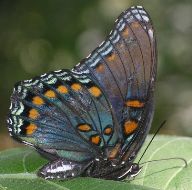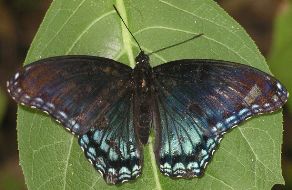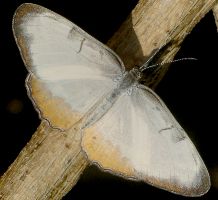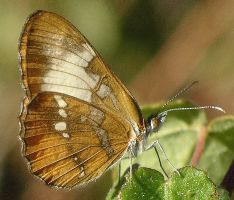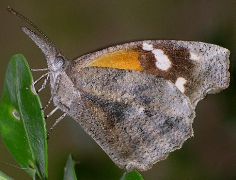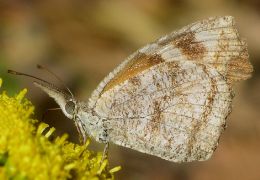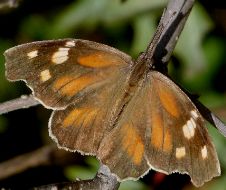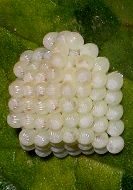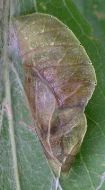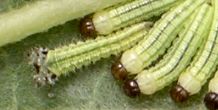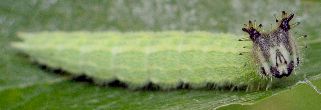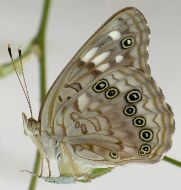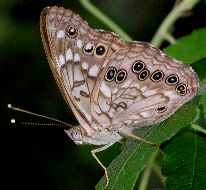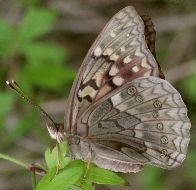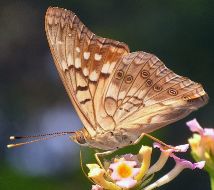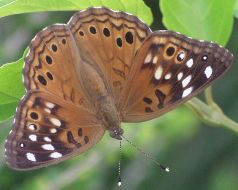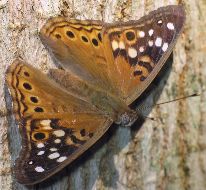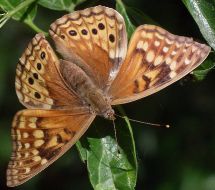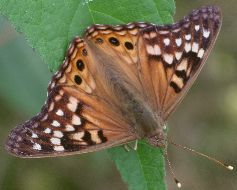
| Nymphalidae ~ Brush-footed Butterflies |
page 1 ![]() page 2
page 2 ![]() page 3
page 3 ![]() page 4
page 4 ![]() page 5
page 5
|
Red-spotted Purples (Limenitis arthemis) do not show up very often here. I've only seen a couple and they are hard to approach. In fact, the accompanying photos are of a very badly injured butterfly, found in a parking lot (it probably fell off the front grill of somebody's automobile). It was not doing very well but at least it couldn't fly away. The dark color and metallic blue are reminiscent of Pipevine Swallowtails minus the tails. The mimicry is probably not accidental, as the Pipevine Swallowtails are distasteful to predators. The undersides of the wings have orange spots, including several scattered near the base of the wings.
The caterpillars of the Red-spotted Purple feed on several trees, including willows and cottonwoods. They resemble bird droppings, even at the young age of the illustrated early instar.
The Common Mestra (Mestra amymone) is unusual for nymphalids. It is white and yellow, much like pierids, instead of the usual darker colors of this family. Although the Common Mestra is considered mainly tropical and only strays this far north, it is sometimes quite abundant and not all individuals look like they have traveled a long distance. Common Mestras tend to rest near the ground, sometimes with their wings open. One of the oddest nymphalids is the American Snout (Libytheana carinenta). Not only does it look sort of weird with its very elongated labial palpi, but it is also the only species in which the females use all six of their legs for walking (the males still use just four). These small orange and gray butterflies sometimes have incredible population explosions, at which time huge flocks of them fly in random migrations to find new habitat. I first saw this as I was driving on I-35 between Austin and San Antonio. The butterflies looked like autumn leaves swirling in the wind as thousands were traveling across the road. The population fluctuations have to do with rainfall and other environmental factors and are quite unpredictable.
When American Snouts hide, they fold their upper wings down behind the lower ones and look amazingly like dead leaves. Their snout even looks like the stem! The color on the underside of the wings is highly variable. During the summer it is usually gray and black and in the winter it is brown. The tops of the wings, seen only occasionally as these butterflies rest with their wings closed most of the time, have distinctive orange markings on dark brown, with white spots on the tips of the forewings. The caterpillars look something like those of sulphurs, but they have the habit of curling their head around, much the way that sawfly larvae do. They feed on hackberry trees.
Two other species are also hackberry specialists. The emperors, like ladies and leafwings, are represented in our area by a pair of species which look quite similar. The Tawny Emperor (Asterocampa clyton) is the most commonly found in the immature stages, but both species of adults are abundant.
The differences begin with the eggs. Only the Tawny Emperor lays eggs in a pyramid of one hundred or more. The Hackberry Emperor (Asterocampa celtis) lays its eggs singly or in small groups. The larvae of the Tawny Emperor remain together in the early stages. Both species' caterpillars have faces that look like masks with two branched horns on top. When the tiny caterpillars hatch, their heads are smooth. With the first molt, though, their head appears to "explode" into the frilly face that characterizes the older caterpillars. Pupae of the emperors are smooth with a strong keel. They are usually found under a leaf on their host tree. Both species of emperors do not visit flowers. However, they may gather in large numbers on tree sap or fruit. They are not particularly spectacular butterflies, being medium-sized and rather dull orange. However, their behavior can be extremely entertaining. These have to be the most aggressive butterflies there are. Males usually find a perch on a leaf or branch about 6 feet off the ground. With rapid and erratic flight, they will physically attack anything that moves through their "space" including any other butterflies, a ball thrown for a dog, or a person's head as they walk past. I've been hit in the head and neck several times by these insects. It can come as quite a surprise, but once I realize what has happened, it is rather amusing. The emperors perch both with wings closed and open, so it helps to know identification marks on both the upper and lower sides of the wings. The markings can vary in their intensity, not to mention that these rapid flyers are often damaged in their wild antics. One other feature is that the males and females have differently shaped wings. The hind wings of the females are much more rounded while those of the males are almost triangular.
On the underside, the easiest features to look for are the eyespots. The Hackberry Emperor has very large eyespots, on both the fore and hind wings. The Tawny Emperor sometimes has rather large eyespots on the hind wing, but more often they are small and there are none on the forewing.
The top sides of the wings are a bit more difficult. As shown in these photos, it is common for these butterflies to perch with their head down. This positioning probably aids their quick take-offs. Both species have black dots on the hind wings, but the Tawny Emperor usually has a bit of light blue in the centers (hard to see). The forewing of the Hackberry Emperor has at least one large black dot near the outer edge which is lacking in the Tawny Emperor. It doesn't help that the colors of either species can vary from light to dark, so it is difficult to make identifications at a glance. |
page 1 ![]() page 2
page 2 ![]() page 3
page 3 ![]() page 4
page 4 ![]() page 5
page 5
![]()

